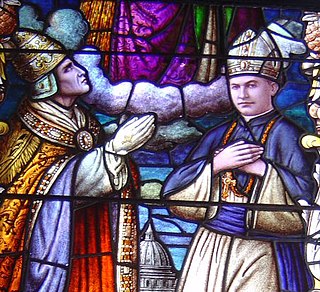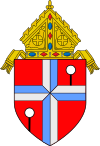
Father Damien or Saint Damien of Molokai or Saint Damien De Veuster, born Jozef De Veuster, was a Roman Catholic priest from Belgium and member of the Congregation of the Sacred Hearts of Jesus and Mary, a missionary religious institute. He was recognized for his ministry, which he led from 1873 until his death in 1889, in the Kingdom of Hawaiʻi to people with leprosy, who lived in government-mandated medical quarantine in a settlement on the Kalaupapa Peninsula of Molokaʻi.

The Congregation of the Sacred Hearts of Jesus and Mary abbreviated SS.CC., is a Catholic clerical religious congregation of Pontifical Right for priests and brothers. The congregation is also known as the Picpus because their first house was on the Rue de Picpus in Paris, France.

The Roman Catholic Bishop of Honolulu is the diocesan bishop of the Catholic Diocese of Honolulu in the United States, the Latin Church ecclesiastical territory over the entire state of Hawaii and the unincorporated Hawaiian Islands. The Honolulu diocese is a suffragan see in the ecclesiastical province administered by the metropolitan Archbishop of San Francisco. The Bishop of Honolulu is a member of the United States Conference of Catholic Bishops. He has two ecclesiastical seats: the Cathedral Basilica of Our Lady of Peace and the Co-Cathedral of Saint Theresa of the Child Jesus, both located in the City of Honolulu.

Our Lady of Peace, Mother of Peace, Queen of Peace or Our Lady Queen of Peace is a title of the Blessed Virgin Mary in the Roman Catholic Church. She is represented in art holding a dove and an olive branch, symbols of peace. Her official memorial in the General Roman Calendar is on July 9 in the universal Church except for Hawaii and some churches in the United States, where it is kept on January 24.

Hawaiian architecture is a distinctive architectural style developed and employed primarily in the Hawaiian Islands. Though based on imported Western styles, unique Hawaiian traits make Hawaiian architecture stand alone against other styles. Hawaiian architecture reflects the history of the islands from antiquity through the kingdom era, from its territorial years to statehood and beyond.

The Cathedral Church of Saint Andrew, also commonly known as St. Andrew's Cathedral, is a cathedral of the Episcopal Church in the United States located in the State of Hawaii. Originally the seat of the Anglican Church of Hawaii, it is now the home of the bishop of the Episcopal Diocese of Hawaii. It is affiliated with St. Andrew's Schools, which consists of the main girls' K-12 school, the coeducational Queen Emma Preschool and a boys' preparatory school (elementary).

The Co-Cathedral of Saint Theresa of the Child Jesus is a co-cathedral of the Roman Catholic Church and its Diocese of Honolulu, located in Kalihi-Palama in the outskirts of downtown Honolulu, Hawaii. The principal cathedral of the diocese remains the Cathedral Basilica of Our Lady of Peace. It was named in honor of the Saint Theresa of the Child Jesus.

Joseph Anthony Ferrario was the third bishop of the Roman Catholic Diocese of Honolulu and served from 1982 to 1993.

The Roman Catholic Diocese of Honolulu is a Latin Church ecclesiastical territory or diocese for the state of Hawaii in the United States. It is a suffragan diocese in the ecclesiastical province of the metropolitan Archdiocese of San Francisco.

Bishop Stephen Peter Alencastre, SSCC was a bishop of the Roman Catholic Church who served as the fifth and last Vicar Apostolic of the Vicariate Apostolic of the Hawaiian Islands. He was also an apparent titular bishop of Arabissus.

Gulstan Ropert, SS.CC., of the Congregation of the Sacred Hearts of Jesus and Mary served as the third vicar apostolic of the Apostolic Vicariate of the Hawaiian Islands - now the Roman Catholic Diocese of Honolulu, from 1892 to 1903.

Herman Koeckemann, formally Bernard Hermann Koeckemann, SS.CC.,, served as the second vicar apostolic of the Vicariate Apostolic of the Sandwich Islands — now the Roman Catholic Diocese of Honolulu — from 1881 to 1892.

Louis-Désiré Maigret, SS.CC., served as the first vicar apostolic of the Vicariate Apostolic of the Sandwich Islands, now the Roman Catholic Diocese of Honolulu. Born in Saint-Pierre-de-Maillé, France, Maigret was ordained to the priesthood as a member of the Congregation of the Sacred Hearts of Jesus and Mary on September 23, 1828, at the age of 24. As part of his missionary work, Father Maigret sailed to the Kingdom of Hawaiʻi to help build its Catholic community of native Hawaiians.

Marianne Cope, OSF, was a German-born American religious sister who was a member of the Sisters of St. Francis of Syracuse, New York, and founding leader of its St. Joseph's Hospital in the city, among the first of 50 general hospitals in the country. Known also for her charitable works, in 1883 she relocated with six other sisters to Hawaiʻi to care for persons suffering leprosy on the island of Molokaʻi and aid in developing the medical infrastructure in Hawaiʻi. Despite direct contact with the patients over many years, Cope did not contract the disease.
Saint Anthony Catholic Church in Honolulu is a parish in the West Honolulu Vicariate Forane of the Roman Catholic Diocese of Honolulu.

Most Sacred Heart of Jesus Catholic Church in Hāwī, North Kohala, is a historic parish in the West Hawaii Vicariate of the Catholic Diocese of Honolulu. The parish campus includes an architecturally remarkable historic church, a rectory, a church cemetery, and a parish hall.

Clarence Richard Silva, known as Larry Silva, is an American prelate of the Catholic Church who has been serving as bishop of the Diocese of Honolulu in Hawaii since 2005.

Sacred Heart Church-Punahou is located at 1701 Wilder Avenue, in Honolulu, in the U.S. state of Hawaii. The church was dedicated in 1914, and its adjacent Bachelot Hall was dedicated in 1923. The property's rectory was built in 1927. It was added to the National Register of Historic Places listings on February 6, 2001.








































